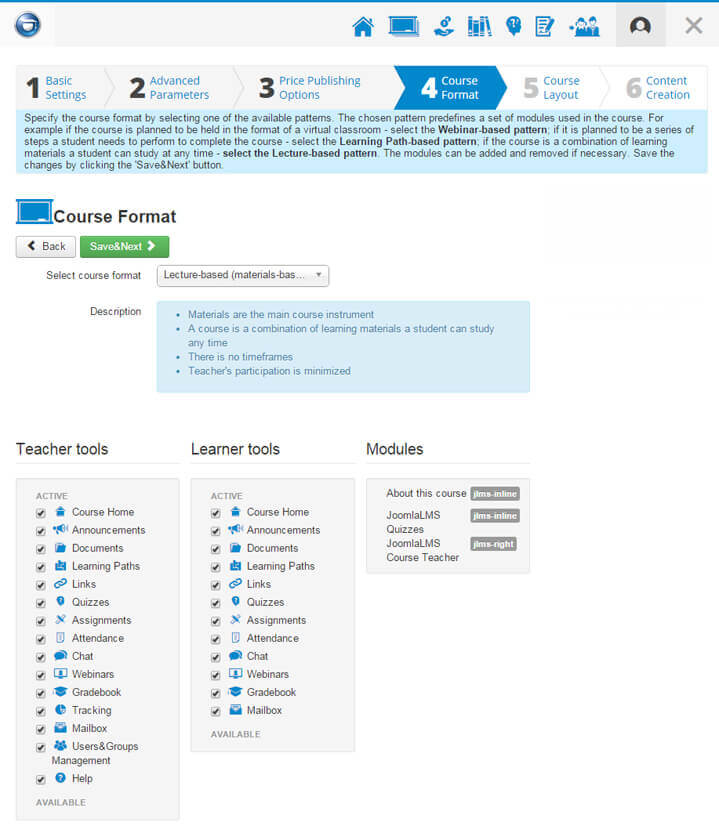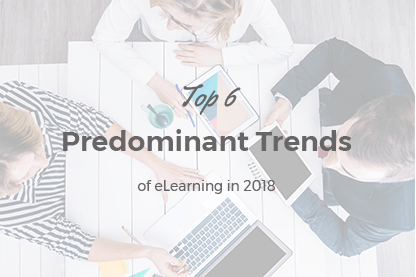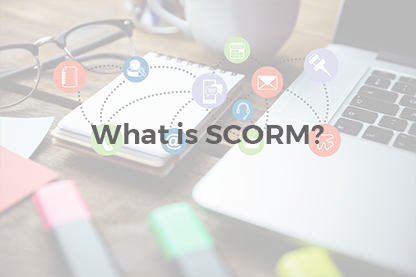In the JoomLMS 2.0 release we changed the concept of course creation by adding an embedded course builder and predefined course patterns: a learning path-based, a webinar-based and a materials-based one. The primary goal of the patterns was to cut the course creation time, free users from entering JoomLMS Back End and allow them to build courses depending on the preferred instructional strategy, a model of learning and the role of an instructor.

In the JoomLMS 2.0 release we changed the concept of course creation by adding an embedded course builder and predefined course patterns: a learning path-based, a webinar-based and a materials-based one. The primary goal of the patterns was to cut the course creation time, free users from entering JoomLMS Back End and allow them to build courses depending on the preferred instructional strategy, a model of learning and the role of an instructor.
In this article we would like to explain to you how to use the patterns to build effective eLearning courses and save time on course creation and management.
If you enter the fourth step of the course builder named “Course Format” you will see that each pattern has a main course instrument, teachers and learners tools and modules.
 Learning-path based pattern
Learning-path based pattern
The main characteristics:
- Learning Path – the main course instrument
- A course – a series of steps a student needs to take to pass the course
- Teacher’s participation is insignificant
A learning path is a so-called route a learner takes though the eLearning course. By setting the course prerequisites you can set directions for students. For example create separate Learning Paths for different aspects of the course or don’t allow to proceed further until the previous step or a whole Learning Path is completed (personalized approach in eLearning).
Moreover, learning paths allow you to make your eLearning course well-structured and students motivated as they know where the course is heading.

The pattern is well suited for:
- Language courses (from a beginner level to the advanced);
- For employee training (from novice to expert or depending on the function: sales, management, marketing etc.);
- School subjects teaching (chemistry, math, geography, engineering etc.);
- Personal skills development (social skills, writing, reasoning etc.)
With the help of the above mentioned approach you can realize the following models of learning:
- Content chunking (dividing the course into small pieces (chunks));
- Personalized learning (eLearning course customization based on individual needs and characteristics);
- Grouping and prioritizing content (according to topic, theme, subject, lesson…)
How to create a learning-path based-course:
- Select the learning-path based pattern while building a course;
- Open the Learning Path section at the “Content creation step”;
- Create a new learning path or Import SCORM. To learn how to create a learning path please watch the tutorial;
- Add content to the learning path (the content needs to be added at corresponding sections first, then added as steps to the Learning Path);
- Specify pre-requisites;
- Save and publish the course.
The main characteristics:
- A webinar – the main course instrument
- A course – a virtual classroom with a predefined framework
- Teacher’s participation is significant
A webinar is an analogue to face-to-face communication the distant education is missing. With the help of webinar tools a teacher communicates with students and compensates the lack of personal meetings.
The pattern is intended to increase the level of engagement, set an advanced level of communication and help students to feel like they are at the same classroom.

The pattern is well suited for:
- Event management;
- Virtual classroom organization;
- Employee training;
- Recruitment;
- Team building;
- Small groups discussions;
- Online lectures.
Supported models of learning include:
- Social learning;
- Asynchronous leaning (mix of real-time interactions and self-paced learning);
- Blended learning (a combination of classroom and distant learning);
- Flipped Learning;
- Collaborative learning.
How to create a webinar- based course:
- Select the webinar-path based pattern while building a course;
- Open the Webinars section at the “Content creation step”;
- At the Webinars page click “new”, fill in the fields of the opened form and publish the webinar.
- Add content if necessary.
! GoToMeeting tool needs to be set up. To learn more about the GoToMeeting Conference Tool configuration please read the manual here.
Lecture-based patternThe main characteristics:
- Materials – the main course instrument
- A course – a combination of materials available for studying
- Teacher’s participation is minimized
Lecture-based pattern like no other requires self-discipline, self-motivation and time-management skills from a student as they become fully responsible for the learning process.

The pattern is well suited for:
- The programs for the improvement of professional skills;
- Term-based courses in which a student can register and start at any time. The only condition is a specified number of weeks in which to complete.
- The courses, where reviewing the materials is necessary to understand the course;
- Product features demonstration: a user needs to look though the features and apply the knowledge in practice.
Materials-based pattern is great for the following learning models:
- Personized learning (a student can study at their own speed, with no pressure that exists in other types of learning);
- Blended learning (in addition to classroom teaching a student is asked to read a book, write an essay, review the materials, watch a recorded webinar etc.)
- Content chunking (making course materials easy to digest).
How to create a lecture-based course:
- Specify the course time-frame;
- Select the lecture- based pattern while building a course;
- Open the Documents section at the “Content creation step”;
- Add new documents. Please watch a tutorial if necessary.
- Publish the course.
Of course, there is no need to stick to just one course pattern or instructional strategy. To receive the best possible outcome we recommend you accommodate different learning styles depending on course specifics and audience characteristics.
What to read next?
10 Reasons to Build Your ELearning Project With JoomLMS [Infographic]
How to Customize the Layout of JoomLMS
eLearning Project Launch CheckList








